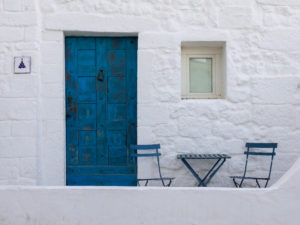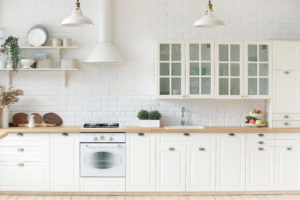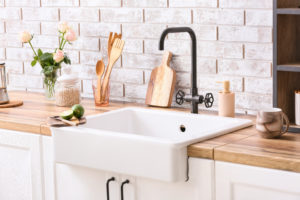
Brick homes are easy to maintain and have a beautiful, traditional style that’s appealing to almost everyone. But older brick homes can look dated or stale thanks to the vintage brick colors, like dark red, tan or peachy rose. Adding whitewash to a brick exterior can instantly update the look of your home – but so can limewash. How do you know which to choose?
Limewash vs Whitewash for Brick
While they sound similar, limewash and whitewash are two different finishes, with different results in the end product.
Whitewash is actually water-based paint that’s mixed with water, then spread onto the brick in thin layers. It gives brick an appealing, weathered look.
Limewash, however, doesn’t have any paint in it. It’s actually crushed limestone that’s combined with water to make a putty, then thinned again to create a chalky, paint-like material.

Pros and Cons of Whitewash
Whitewash has some pros:
- You can use it to whitewash a brick exterior, but you can also use it indoors.
- Because whitewash is basically a paint extender – water mixed with paint – it’s cheap.
- It smooths rough surfaces.
- You can use paint you already have on hand.
- It’s fast and easy to apply and dries quickly.
- When applied correctly, it can last up to 20 years with little maintenance.
It also has some cons, though:
- It can be tough to keep the paint evenly blended, which can make it difficult to get an coverage; as a result, you may have to apply the paint several times.
- Some homeowners may prefer a rough finish, rather than the smooth finish created by whitewashing brick exteriors.
- It’s permanent.
- Whitewash only comes in white.

Pros and Cons of Limewash
Like whitewash, limewash comes with its own pros and cons. The pros are:
- You can use it indoors or out.
- Because of its blend of lime, minerals and water, which soaks into the brick, you can see the brick’s texture.
- It can be applied in one coat*.
- You can wipe it off up to five days after you apply it.
- Limewash comes in a variety of shades, including white, taupe, brown and gray.
The cons to using limewash are:
- It can be hard to get the limewash to blend with water if you’re mixing by hand.
- It costs more than paint.
- It isn’t as long-lasting as whitewash – while it won’t flake like paint, it still needs touch-ups regularly, and usually has to be redone every 5-7 years.
So … Is it Better To Whitewash a Brick Exterior or Limewash it?
Choosing whether to whitewash your exterior brick or limewash it can be a tough call. If you’re still not sure, talk with the exterior paint pros at Paintzen or reach out for a free estimate. The brick home of your dreams awaits.
*Some colors, or drastic color changes, may require more than one coat to achieve a uniform finish.